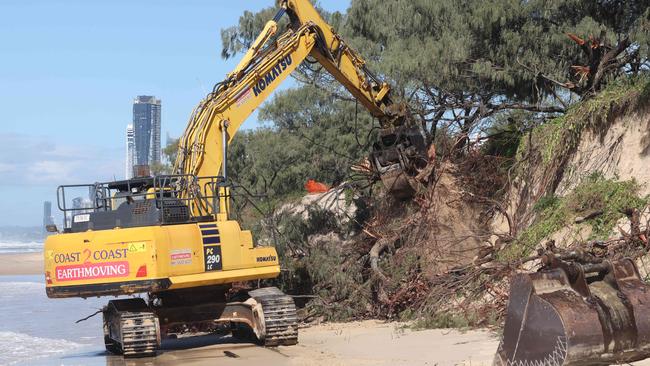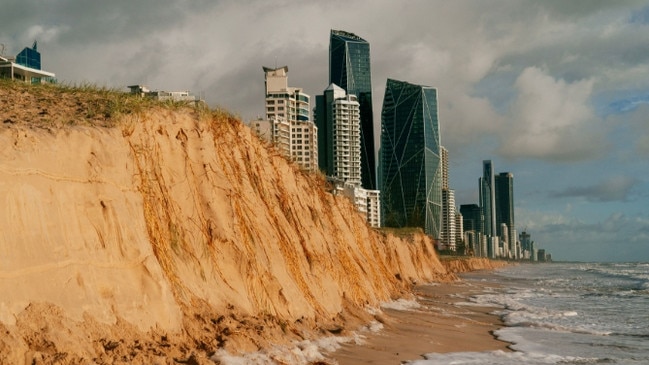Mark Ellis from Bond University says the Gold Coast must act now if we want to save beaches
The dramatic beach erosion left in the wake of ex-Tropical Cyclone Alfred has laid bare a truth that many coastal scientists have warned about for years. Read why

Gold Coast
Don't miss out on the headlines from Gold Coast. Followed categories will be added to My News.
The dramatic beach erosion left in the wake of ex-Tropical Cyclone Alfred has laid bare a truth that many coastal scientists have warned about for years - the forces reshaping our shoreline are becoming more extreme, more frequent, and more difficult to manage.
As delegates gather this week in Surfers Paradise for the National Coastal Conference, the challenges facing our beaches are front and centre.
But the time for discussion alone has passed. We need bold, strategic action to protect what remains of our coastline.
Erosion is not new. Beaches are, by their very nature, dynamic environments shaped by wind and tide.
But what we’re seeing now is not just natural variability; it’s an acceleration driven by climate extremes that are no longer rare but recurring.
The CSIRO’s 2022 Our Future World report warned us that ‘climate extremes and unprecedented weather events are becoming increasingly frequent and impactful’. We’re now living that reality.
Mayor Tom Tate is right when he says the Gold Coast will face more damaging and expensive storms as climate change progresses.

At the moment, the city council is doing the best they can in terms of restoration efforts in the face of ongoing rough seas.
But this is not a one-off. We need to think seriously about what we are doing to prepare for that future.
Nature made a mockery of the council’s Easter deadline to repair the foreshore, as yet another round of rough seas pushed efforts back. This is the new normal.
Storm surges like those that continue to impact Surfers Paradise are triggered by intense coastal storms and low-pressure systems.
When combined with rising sea levels, these surges can reach further inland and do more damage than ever before. Their impact depends on a storm’s intensity, size, path, and speed - variables that are increasingly unpredictable in a warming world.
Science is clear that warming seas are fueling more energetic weather systems.
Sea surface temperatures in the Coral Sea have been consistently above the historical average since 1998, and nine of the 10 warmest years on record have occurred since 2000.
These warmer waters supercharge storm systems, altering wave patterns and increasing their energy. When those waves arrive at the coast during king tides or cyclonic conditions, they hit harder and reach further.
Research shows these trends will likely continue and our beaches will come under ever greater pressure.
Erosion is not just about water. Onshore winds help rebuild dunes, catching sand behind vegetation.

But when that vegetation is damaged - by foot traffic, by events like the air show or SeaFire, or by poorly placed infrastructure - dunes can’t do their job.
We saw this firsthand at the View Avenue beach access, where damage to the dunes made the area more vulnerable to erosion during storms.
Hard structures like seawalls may protect property in the short term, but they come at a cost.
They interfere with natural sand movement, leading to what are known as ‘edge effects’, where erosion intensifies at the boundaries of protection.
Without room for dunes to migrate and rebuild, the beach itself is squeezed out of existence.
Insurance reports, like those from IAG, are already sounding the alarm. Rising seas and stronger storms will escalate damage to both natural systems and built environments.
Sand dunes are not optional luxuries – they are our frontline defence and vital infrastructure.
So what’s the solution?
First, we must invest in long-term, adaptive coastal management strategies, not just reactive fixes.
That means thoughtful dune restoration, strategic retreat in high-risk zones, and limiting damaging activity on fragile beachfronts.
It means integrating climate science into every aspect of urban planning, not treating it as an afterthought.
Second, we need a community-wide conversation about what we’re willing to do, and what we are willing to give up, to preserve our beaches.
Events that draw tourists are important, but not if they degrade the very asset people come to see.
The Gold Coast is blessed with stunning beaches that define our lifestyle and economy.
But without smart, science-backed adaptation, we risk losing them. Not to some distant future, but to the very next storm.
If we want our beaches to be here for the next generation, we must act decisively now. Nature is no longer waiting.
Mark Ellis is a coastal erosion researcher at Bond University.

Originally published as Mark Ellis from Bond University says the Gold Coast must act now if we want to save beaches


